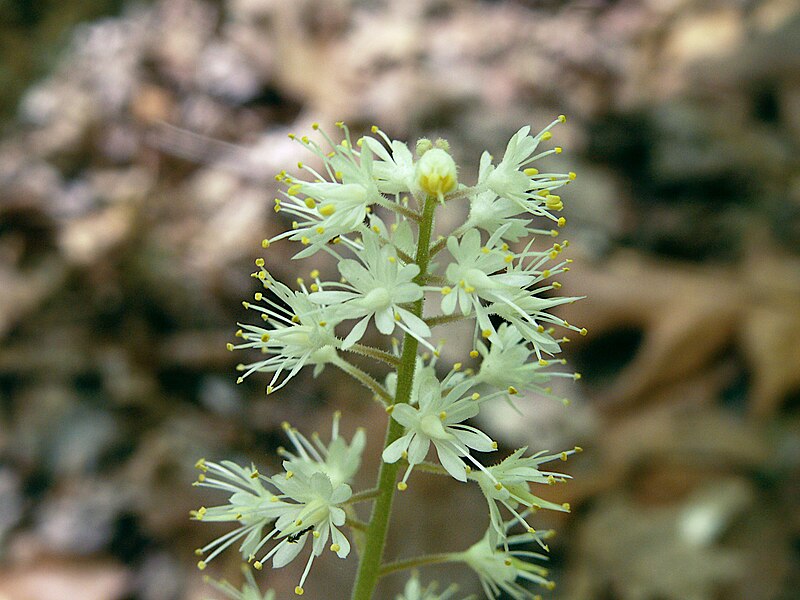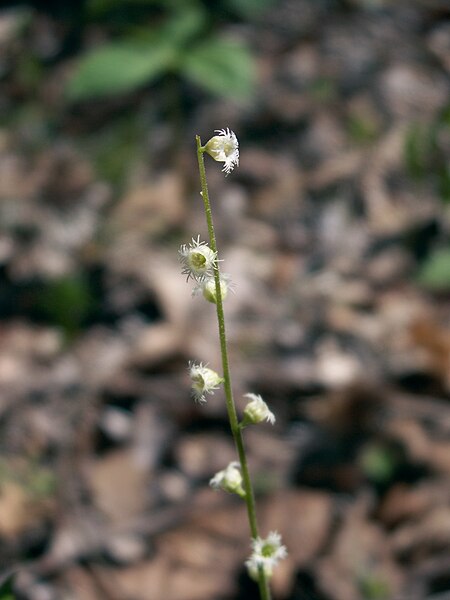
These delicate members of the Saxifrage family prefer the banks of a woodland stream; these were blooming in Bird Park, Mount Lebanon.

For a description of the species, see the Tiarella cordifolia reference page.

These delicate members of the Saxifrage family prefer the banks of a woodland stream; these were blooming in Bird Park, Mount Lebanon.

For a description of the species, see the Tiarella cordifolia reference page.

Miterwort flowers are tiny but ornate. They also defied our autofocus, so these pictures had to be focused manually.
For a description of the species, see the Mitella diphylla reference page.

 The Miterwort is a flower that rewards a close examination: a casual glance would never reveal the intricate snowflake fringes on the individual flowers. These plants were blooming in late April along the Trillium Trail in Fox Chapel.
The Miterwort is a flower that rewards a close examination: a casual glance would never reveal the intricate snowflake fringes on the individual flowers. These plants were blooming in late April along the Trillium Trail in Fox Chapel.
Gray describes the genus and the species:
MITELLA [Tourn.] L. MITERWORT, BISHOP’S CAP. Calyx short, adherent to the base of the ovary, 6-cleft. Petals 5, slender. Stamens 5 or 10, included. Styles 2, very short. Capsule short, 2-beaked, 1-celled, with 2 parietal or rather basal several-seeded placentae, 2-valved at the summit. Seeds smooth and shining. Low and slender perennials, with round heart-shaped alternate slender-petioled leaves on the rootstock or runners, and naked or 2-few-leaved flowering steins. Flowers small, in a simple slender raceme or spike. Fruit soon widely dehiscent. (Diminutive ofmitra, a cap, alluding to the form of the young pod.)
M. diphylla L. Hairy; leaves heart-shaped, acute, somewhat 3-5-lobed, toothed, those on the many-flowered stem 2, opposite, nearly sessile, with interfoliar stipules; flowers white, in a raceme (1.5-2 dm. long); stamens 10. Rich woods, Que. and N. E. to N. C., w. to Minn., Ia., and Mo. May.
 Obviously this is one of our favorite flowers, since this is its third time being featured here. (More pictures are here and here.)
Obviously this is one of our favorite flowers, since this is its third time being featured here. (More pictures are here and here.)
As we see here, some forms of this species grow leaves with deep red markings along the veins, and those forms have been developed into cultivated varieties with even more pronounced red markings. All the plants in this hollow in Schenley Park had the red markings on their leaves. They were blooming in early May, a little later than usual this year.
The pictures in this particular article have been donated to Wikimedia Commons under the Creative Commons CC0 1.0 Universal Public Domain Dedication. Do what you like with them; no permission is needed.
Gray describes the genus and the species:
TIARELLA L. FALSE MITERWORT. Calyx bell-shaped, 5-parted. Petals 5, with claws. Stamens long and slender. Styles 2. Capsule membranaceous, 2-valved; the valves unequal. Seeds few, at the base of each parietal placenta, globular, smooth. Perennials; flowers white. (Name a diminutive from tiara, a tiara, or turban, from the form of the pistil, which is like that of Mitella, to which the name of Miterwort properly belongs.)
T. cordifolia L. Leaves from the rootstock or summer runners, heart-shaped, sharply lobed and toothed, sparsely hairy above, downy beneath; stem (1-4 dm. high) leafless or rarely with 1 or 2 leaves; raceme simple; petals oblong, often subserrate. Rich rocky woods, N. S. and N. B. to Minn., Ind., and southw. in the mts. Apr.-June.
 A very close view of the delicately fringed flowers. This plant grew in the Squaw Run valley, where it was blooming in early May. A general view of the entire plant is here.
A very close view of the delicately fringed flowers. This plant grew in the Squaw Run valley, where it was blooming in early May. A general view of the entire plant is here.
Gray describes the genus and the species:
MITELLA [Tourn.] L. MITERWORT, BISHOP’S CAP. Calyx short, adherent to the base of the ovary, 6-cleft. Petals 5, slender. Stamens 5 or 10, included. Styles 2, very short. Capsule short, 2-beaked, 1-celled, with 2 parietal or rather basal several-seeded placentae, 2-valved at the summit. Seeds smooth and shining. Low and slender perennials, with round heart-shaped alternate slender-petioled leaves on the rootstock or runners, and naked or 2-few-leaved flowering steins. Flowers small, in a simple slender raceme or spike. Fruit soon widely dehiscent. (Diminutive of mitra, a cap, alluding to the form of the young pod.)
M. diphylla L. Hairy; leaves heart-shaped, acute, somewhat 3-5-lobed, toothed, those on the many-flowered stem 2, opposite, nearly sessile, with interfoliar stipules; flowers white, in a raceme (1.5-2 dm. long); stamens 10. Rich woods, Que. and N. E. to N. C., w. to Minn., Ia., and Mo. May.